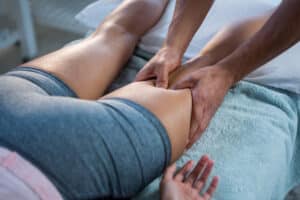Trigger points
Trigger point therapy - targeted pain relief through manual techniques
Muscle tension and myofascial pain can lead to persistent discomfort. The Manual Trigger-Point-Therapy IMTT® targets painful hardening in the muscles to relieve tension and restore mobility.
Trigger points
Trigger point therapy
What are trigger points?
Trigger points are hardened muscle cords that often not only cause localized pain, but can also radiate to other parts of the body (Referred Pain). Common causes are poor posture, lack of exercise or overloading.
Typical symptoms:
✔ Local pressure pain
Radiating pain (e.g. head, neck, back)
✔ Restricted movement and tension
✔ Muscle weakness without a recognizable cause
How does trigger point therapy work?
Our specialized therapists identify the affected areas through targeted questioning, diagnosis and muscle testing. Manual techniques are used to treat the hardened muscle cord in order to relieve tension and promote blood circulation.
Methods of treatment:
✔ Ischemic compression - Targeted pressure to release the trigger point
✔ Targeted stretching & mobilization techniques
✔ Fascia mobilization - Loosening glued structures
Support after treatment Stabilizing exercises with your own body weight or equipment for long-term regeneration. Individual exercise plans help to ensure lasting therapeutic success.
When is trigger point therapy useful?
This method is particularly suitable for:
Chronic muscle tension (e.g. neck, back)
✔ Tension headaches & migraines
✔ Pain caused by poor posture
✔ Sports injuries & muscular imbalances
More freedom of movement - less pain
Don't let muscular discomfort become a permanent problem. Make an appointment now for a targeted trigger point treatment and feel the difference!
FAQ Dry Needling
Dry needling is a technique in which fine needles are inserted into specific trigger points within the affected muscles. These trigger points are often hardened or tense muscle areas that can cause pain.
Although both techniques use needles, they differ fundamentally in their approach and philosophy. Dry needling is based on Western medical science and focuses on trigger points and muscle tissue, while acupuncture is part of traditional Chinese medicine and stimulates energetic meridians.
Dry needling is often used for the treatment of:
- Muscular trigger points
- Myofascial pain syndromes
- Chronic pain
- Spasticity in neurological patients
- Acute and chronic orthopaedic complaints
The potential benefits of dry needling include
- Pain reduction
- Improving the range of motion
- Reduction of muscle tension
- Acceleration of the healing process for injuries
The therapist carries out a comprehensive assessment and identifies the trigger points to be treated. The needles are then inserted directly into these trigger points. This is often followed by gentle manipulation of the needle to maximize the therapeutic effect.
Some patients experience slight discomfort or muscle twitching when the needle reaches a trigger point. However, most do not feel any significant pain and the discomfort usually subsides quickly.
The most common side effects are
- Temporary pain or tenderness at the injection site
- Slight bleeding or bruising
- Tiredness or general malaise after treatment
Yes, if it is performed by a suitably trained and qualified therapist. Our therapists are specially trained in this technique and use sterile needles to minimize the risk of infection.
Dry needling should be avoided or used with caution under the following conditions:
- Acute infections or skin diseases at the injection site
- Blood clotting disorders or use of anticoagulants
- Severe cardiovascular diseases
- Pregnancy (especially in the first trimester)
- Sensitive or anxious patients who may react strongly to the treatment
Anticoagulants are no longer an absolute contraindication. However, aggravating risk factors must be taken into account:
- Recently initiated medication
- Volatile INR (International Normalized Ratio)
- Intensive sporting activity
- Interdependence with other medications Recommended risk minimization measures include
- the use of acupuncture needles instead of sharpened injection needles and the postneedling compression for 15 seconds.
After the treatment you should:
- Drink plenty of water to promote healing.
- Avoid excessive strain on the treated muscle groups.
- Watch out for unusual symptoms such as severe pain or swelling and contact your therapist if necessary.
The number of treatments required varies depending on the type and severity of the symptoms. Some patients experience an improvement after just a few sessions, while others require several treatments over weeks or months.
Please contact our practice by telephone or via our website to make an appointment. Our team will be happy to answer any further questions you may have and to make an appointment.

